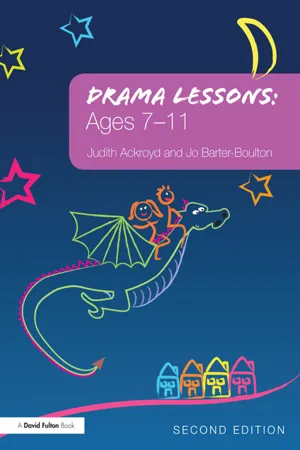
- 128 pages
- English
- ePUB (mobile friendly)
- Available on iOS & Android
Drama Lessons: Ages 7-11
About This Book
Drama Lessons: Ages 7–11 offers an exciting and varied range of tried and tested lessons tailor-made for busy teachers. Drama Lessons: Ages 7–11 emerges from the continuing positive responses to Drama Lessons for Five to Eleven Year Olds (2001).
In this book you will find a carefully chosen selection of the best lessons from the original book, plus some exciting new material – a combination of brand new and classic lessons. This new collection introduces Literacy Alerts which identify how the drama activities develop aspects of literacy and suggest additional literacy activities. For each lesson plan, essential resources and timing information are provided. The lessons cover a range of themes and curriculum areas.Full of pick-up-and-go lesson plans, this book will be of enormous interest to specialists and non-specialists of drama alike. All primary teachers, literacy coordinators and teaching assistants should have this book in their hands and it will give all trainee teachers a flying start in their school placements.
Frequently asked questions
Information
Chapter 1
The Lonely Dragon
Learning objectives
- To explore differences between people;
- To discuss the danger of jumping to conclusions about people;
- To work together to solve problems;
- To use dramatic techniques to explore characters and issues.
Themes
- Fear of the unknown
- Friendship
- Loneliness
- Being misunderstood.
Resources
- Optional: A large piece of ‘dragon-coloured’ material. Large sheets of paper and pens.
Time
- One hour.
Notes

The villagers live in fear
Teacher’s intentions
- To build belief in the setting;
- To introduce the dragon as a threat to the village;
- To tell the beginning of the story collectively, using the children’s ideas.

Discussion and narration: setting the scene
- He would eat them.
- He is frightening.
- He has big claws and might scratch them.
- He breathes fire.
- The people in the village were afraid of the dragon because they thought he might… (Eat them?)
- They believed he would… (Stamp on their houses?)
- They were afraid he was going to… (Breathe fire?)
- They never saw him do any of these things, but they were always afraid he would.


Collective drawing: the dragon


How do we feel when we see the dragon?
Teacher’s intentions
- To continue to build belief in the village, and the threat felt by the villagers;
- To bring the village to life;
- To explore the feelings of the villagers.
Freeze frames: when the dragon comes
- What are you doing?
- Who are you with?
- What are you holding in your hand?
- What’s the weather like today?
- What can you see?
- Tell me what it looks like.
- What can you hear?
- How do you feel?
- Why are you looking so frightened? What are you going to do now?
- What do you think the dragon might do?

Table of contents
- Cover
- Title
- Copyright
- Contents
- Acknowledgements
- Introduction
- Teachers’ Notes
- Glossary
- 1 The Lonely Dragon
- 2 Red Riding Hood
- 3 Rubbish in the River: Environmental issues and journalistic writing
- 4 Romans in Britain
- 5 Building the Pyramid
- 6 Life Cycles
- 7 Reds and Greens: Identity, prejudice and community
- 8 Charles I: An exploration of historical evidence
- 9 World War II: The Home Front: A drama based on two true stories from the 1940s
- 10 Is Emma’s Friend Stealing?
- 11 Where’s the Blame?: A drama script about bullying
- 12 The Mysteries of the World: A fantasy drama that includes formal letter writing and poetry writing
- Recommended reading